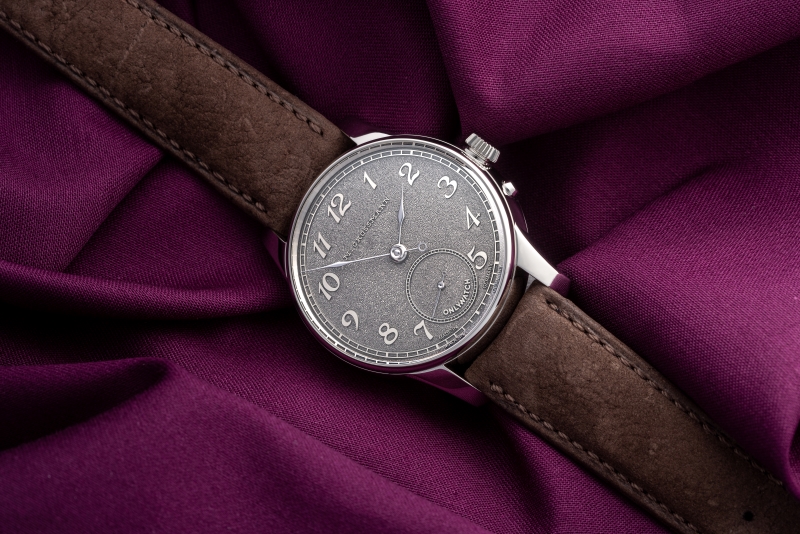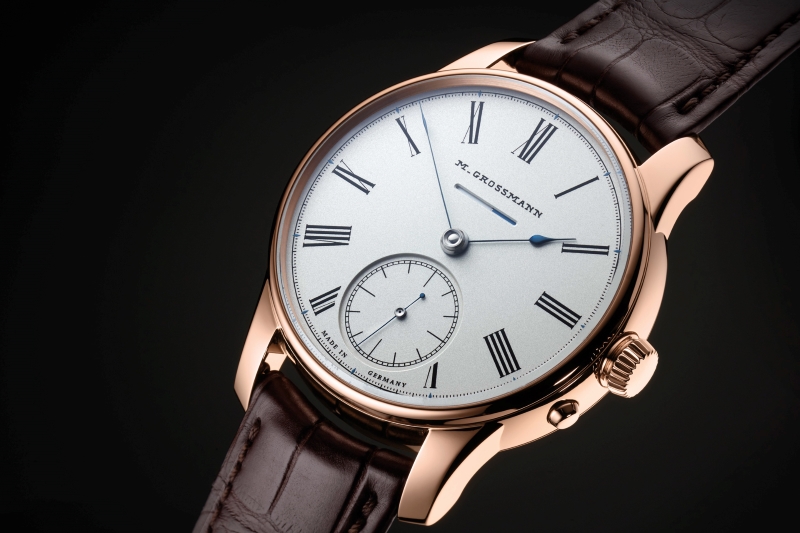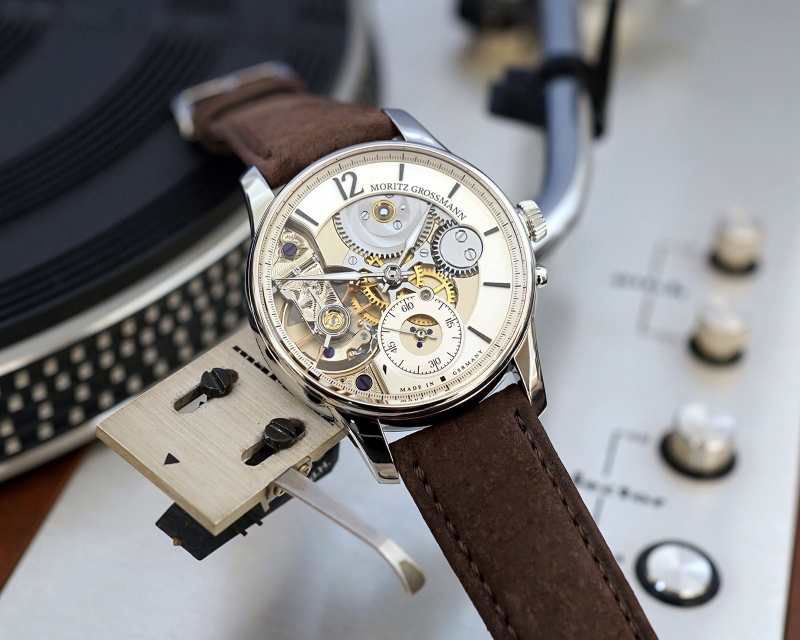
Hutter: Our goal is to increase manufacturing to 800 to 1,000 pieces a year, but until then, we will go slowly step by step because we’d like to keep our quality.
There are four names that make up the cornerstone of the watchmaking industry in Glashütte, Germany: Ferdinand Adolph Lange, Julius Assmann, Adolf Schneider and Moritz Grossmann. These gifted horologists spent their lives travelling and learning, ambitiously and relentlessly pursuing precision. In 1845, after Lange’s request to build a watchmaking centre in Glashütte was approved by the Saxon government, the small mining town, once rich with silver, evolved into a horological mecca as his long-standing watchmaking friends and fellow journeymen joined him at the foot of the Ore Mountains.
Lange’s famed and namesake A. Lange & Söhne was born here while Grossmann established his own manufacture. “Grossmann was one of the most eminent watchmakers in 19th century Glashütte,” says Christine Hutter, founder and CEO of Moritz Grossmann. “He travelled to different European countries and when he came back in 1854, he opened his workshop.” Having developed the Glashütte lathe and later concentrating on lever escapements and the optimisation of pivoted detents for chronometers, Grossmann also crafted precision tools, escapement models, fine pocket watches and precision pendulum clocks as well as lever and marine chronometers.
“The most important thing is, he was a person who wanted to pass all his watchmaking knowledge to others,” Hutter says. Compelled by the desire to teach, Grossmann established the German School of Watchmaking in 1878. “He wrote essays, translated books from other languages into German and also did all the curricular concepts for the school.” Unfortunately, the watchmaker’s life was cut short by an unexpected stroke, putting an end to his inspiring legacy when he was 60, coincidentally the same age as Lange when he died. Grossmann’s manufacture in Glashütte was subsequently liquidated.
mg_tremblage_ow_09.jpg

Hutter, also a trained watchmaker, discovered the Grossmann name during her years in Glashütte, where she cut her teeth at both Glashütte Original and A. Lange & Söhne. At the time, she was nurturing a growing desire to establish her own manufacture. She sought out the rights to the Moritz Grossmann brand with the help of her family. “I recognised the importance of the Moritz Grossmann name and tried to protect it.”
Hutter’s watchmaking origins is sort of an anomaly as it deviates from the usual “I followed in my father’s footsteps” trope. The Eichstätt native was a budding sportswoman, set on pursuing a career in the field. But after obtaining her bachelor’s degree, a friend casually asked: “Hey, what do you think about watchmaking?” It then sparked an interest and curiosity that led Hutter to a three-year watchmaking apprenticeship.
“It was very interesting because I trained to restore historical pieces. I started with clockwatches, and it got smaller and smaller. After that, I got to work on pocket watches and, later on, wristwatches.” Fully entranced by the allure of mechanisms, wielding technical tools as if they were an extension of her fingers and breathing new life into 19th- and 20th-century calibres, Hutter set out in an altogether new direction.
After her time at Glashütte, Hutter soon found herself in Switzerland. “This letter about brand rights had come in and, in that moment, I had a vision, a dream to restart the heritage of Moritz Grossmann again with the highest craftsmanship.” After 120 years of laying dormant, the brand was brought back to life in 2008 with Hutter as its new founder and CEO.
_web_hd_1920x1280_ls_rg_quer.jpg

Today, the Moritz Grossmann brand still adheres to the core tenets practised by its eponymous founding father. In keeping with the concept of manu factum, where everything is made by hand, a whopping 90% of its movements are manufactured within its ateliers. Holding up the Power Reserve Vintage, Hutter says: “Take a look at our hands. Grossmann was a person who used the slimmest and nicest hands in his pocket watches. That’s a little bit of heritage we’d like to show again in our watches.” Closer inspection shows how the second hand is almost as thin as a strand of hair. For the biennial Only Watch auction this year, the manufacture presented the Tremblage, which features a historic engraving technique that involves hand-cutting and carving motifs and patterns onto metal. The brand’s signature is also hand-engraved in cursive script — an homage to the master watchmaker’s vintage pocket watches — and a plate of German silver was used for this exquisite piece.
While Hutter talks about the importance of honouring traditional methods, she also emphasises that copying old watches is out of the question. “We should be innovative and develop new things.” She picks up a rose gold Backpage model, which won the Red Dot Design Award in 2019. It features the Calibre 107.0, mirror-inverted and moved to the side which required numerous additional constructions so details such as the Grossmann balance, ratchet wheel and three-band snailing can be admired from the front.
This year, a special and very limited edition Backpage was released in collaboration with Swiss cellist Martin Tillman — a virtuoso whose track record includes scores for The Dark Knight and The Da Vinci Code — to celebrate his role as Moritz Grossmann’s new brand ambassador. The Tillman Electric Cello watch has the instrument recessed into the caseback with a tremblage finish.
mg-martintillmann-3.1.jpg

The Tefnut Twist, meanwhile, puts a unique spin on a conventional winder. Moritz Grossmann’s original solution incorporates the winder into the strap so the action is easier for smaller, more delicate watches. The ladies’ piece requires only six full rotations to kickstart its 48-hour power reserve. The spectacular Tourbillon also introduces a creative solution to smoothly halt the balance wheel. As a gentle and reliable material was needed,Hutter presented her own hair. It was made into a brush and became the perfect stop device. Now, buyers can request that their own lock of hair be incorporated into their tourbillon.
These days, Hutter rarely finds herself at the watchmaking table anymore but assures she is still involved in all the company’s processes. She is proud of her team of 50, saying: “Without them, we wouldn’t be able to work. We are young; we are flexible. If they have ideas, we sit together and discuss.” There are advantages to being small and independent, too. “After making a decision, we can get up from the table and start working. In bigger companies, it goes through so many levels before somebody else finally decides.
“We know we are still missing some complications. We do not have a chronograph or a minute repeater yet. There are a lot of things we can do but we need time. Our goal is to increase manufacturing to 800 to 1,000 pieces a year, but until then, we will go slowly step by step because we’d like to keep our quality.”
Hutter says consumers have a better understanding of watchmaking technicalities now. “They are no longer looking for commercial watches, but unique pieces, which not everybody has. And that’s good because the independents do small editions.” Moritz Grossmann entered the Malaysian market this year with Sincere Fine Watches and is doing exceptionally well in Asia. “At the moment, the demand is very high. We’re fully booked and all the retailers would like to get more watches. We’re doing our best,” she adds.
This article first appeared on Sept 4, 2023 in The Edge Malaysia.


